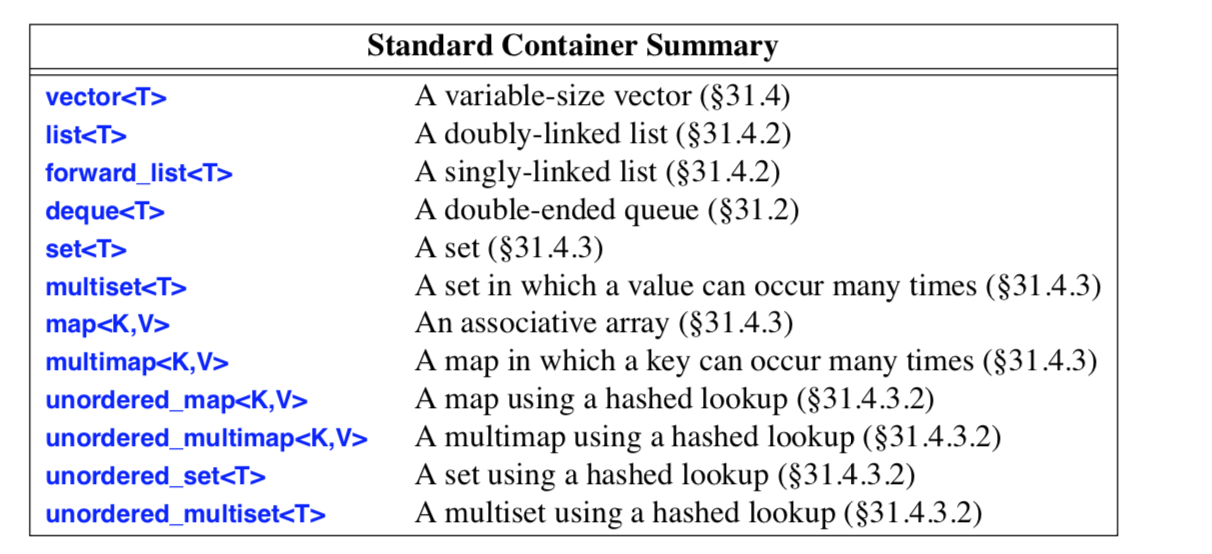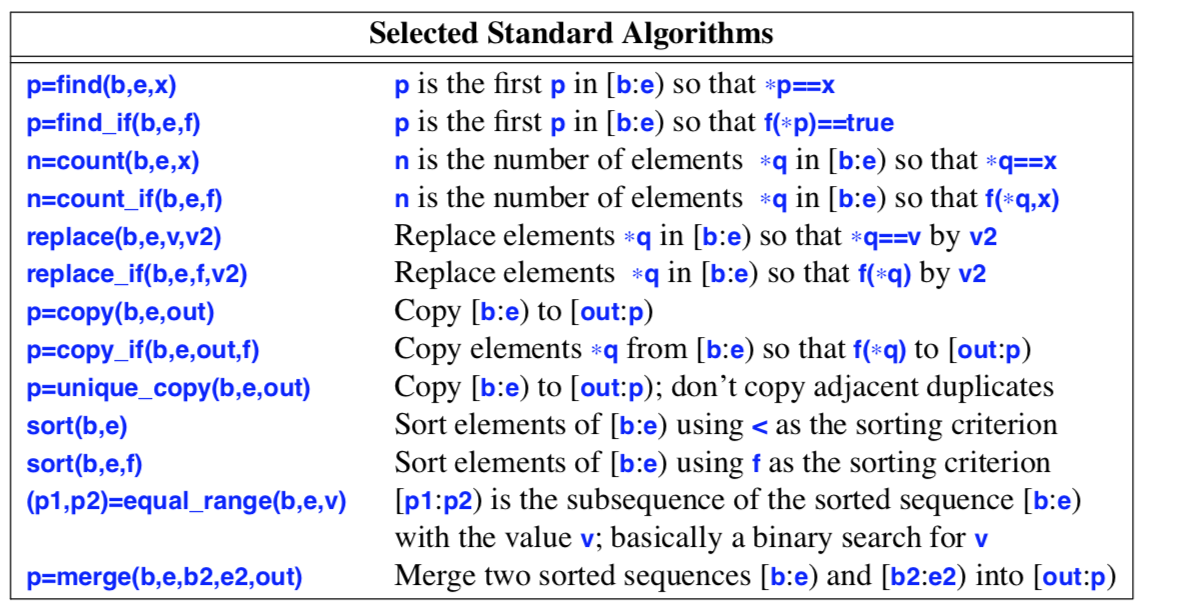When defining a variable, you don’t actually need to state its type explicitly when it can be deduced from the initializer:
auto b = true; // a bool
auto ch = 'x'; // a char
auto i = 123; // an int
auto d = 1.2; // a double
auto z = sqrt(y); // z has the type of whatever sqrt(y) returns
With auto, we use the = syntax because there is no type conversion involved that might cause problems (§6.3.6.2). We use auto where we don’t have a specific reason to mention the type explicitly. ‘‘Specific reasons’’ include:
- The definition is in a large scope where we want to make the type clearly visible to readers of our code.
- We want to be explicit about a variable’s range or precision (e.g., double rather than float)
- Using auto, we avoid redundancy and writing long type names. This is especially important in generic programming where the exact type of an object can be hard for the programmer to know and the type names can be quite long (§4.5.1).
- const: meaning roughly ‘‘I promise not to change this value’’ (§7.5). This is used primarily to specify interfaces, so that data can be passed to functions without fear of it being modi- fied. The compiler enforces the promise made by const.
- constexpr: meaning roughly ‘‘to be evaluated at compile time’’ (§10.4). This is used primar- ily to specify constants, to allow placement of data in memory where it is unlikely to be corrupted, and for performance.
// For example:
const int dmv = 17; // dmv is a named constant
int var = 17; // var is not a constant
constexpr double max1 = 1.4∗square(dmv); // OK if square(17) is a constant expression
constexpr double max2 = 1.4∗square(var); // error: var is not a constant expression
const double max3 = 1.4∗square(var); // OK, may be evaluated at run time
double sum(const vector<double>&); // sum will not modify its argument (§2.2.5)
vector<double> v {1.2, 3.4, 4.5}; // v is not a constant
const double s1 = sum(v); // OK: evaluated at run time
constexpr double s2 = sum(v); // error: sum(v) not constant expression
For a function to be usable in a constant expression, that is, in an expression that will be evaluated by the compiler, it must be defined constexpr. For example:
constexpr double square(double x) { return x∗x; }
To be constexpr, a function must be rather simple: just a return-statement computing a value.A constexpr function can be used for non-constant arguments, but when that is done the result is not a constant expression. We allow a constexpr function to be called with non-constant-expression argu- ments in contexts that do not require constant expressions, so that we don’t have to define essen- tially the same function twice: once for constant expressions and once for variables. In a few places, constant expressions are required by language rules (e.g., array bounds (§2.2.5, §7.3), case labels (§2.2.4, §9.4.2), some template arguments (§25.2), and constants declared using constexpr). In other cases, compile-time evaluation is important for performance. Independently of performance issues, the notion of immutability (of an object with an unchangeable state) is an important design concern (§10.4).
- constexpr -> for expressions to evaluate, uses constant variabes to evaluate, also it is evaluated on compile-time
- const -> constant values
- const vs define : const is for elements that have interaction with the problem, define is a preprocessor indicative, only substitutes and has a global scope
switch - case & if
char answer = 0;
cin >> answer;
switch (answer) {
case 'y':
return true;
case 'n':
return false;
default:
cout << "I'll take that for a no.\n";
return false;
}
A pointer variable can hold the address of an object of the appropriate type:
char∗ p = &v[3]; // p points to v’s fourth element
char x = ∗p; // *p is the object that p points to
In an expression, prefix unary ∗ means ‘‘contents of’’ and prefix unary & means ‘‘address of.’’
C++ also offers a simpler for-statement, called a range-for-statement, for loops that traverse a sequence in the simplest way:
void print() {
int v[] = {0,1,2,3,4,5,6,7,8,9};
for (auto x : v) // for each x in v
cout << x << '\n';
// ...
}
If we didn’t want to copy the values from v into the variable x, but rather just have x refer to an element, we could write:
void increment() {
int v[] = {0,1,2,3,4,5,6,7,8,9};
for (auto& x : v)
++x;
// ...
}In a declaration, the unary suffix & means ‘‘reference to.’’ A reference is similar to a pointer, except that you don’t need to use a prefix ∗ to access the value referred to by the reference. Also, a reference cannot be made to refer to a different object after its initialization.
We give the pointer the value nullptr (‘‘the null pointer’’). There is only one nullptr shared by all pointer types.
It is often wise to check that a pointer argument that is supposed to point to something, actually points to something:
int count_x(char∗ p, char x)
// count the number of occurrences of x in p[]
// p is assumed to point to a zero-terminated array of char (or to nothing)
{
if (p==nullptr)
return 0;
int count = 0;
for (; ∗p!=0; ++p)
if (∗p==x)
++count;
return count;
}Differecence betweent a class and struct ist that the class has the encapsulation of memebers and methods
In addition to classes, C++ supports a simple form of user-defined type for which we can enumer- ate the values:
enum class Color { red, blue, green };
enum class Traffic_light { green, yellow, red };
Color col = Color::red;
Traffic_light light = Traffic_light::red;
The definition (interfaces) (what is required by the constructors and methods is usually defined on a h header)
Definition -> Interfaces <- Usage
A mechanism for expressing that some declarations belong together and that their names shouldn’t clash with other names.
To gain access to names in the stan- dard-library namespace, we can use a using-directive (§14.2.3):
using namespace std;Namespaces are primarily used to organize larger program components, such as libraries. They simplify the composition of a program out of separately developed parts.
if (s<0) throw length_error{};
elem = new double[s];
sz = s;
void test() {
try {
Vector v(−27);
}
catch (std::length_error) {
// handle negative size }
catch (std::bad_alloc) {
// handle memory exhaustion
} }
In general,
static_assert(A,S)
Prints S as a compiler error message if A is not true.
Virtual Functions are used to support Runtime Polymorphism.
That is, virtual keyword tells the compiler not to make the decision (of function binding) at compile time, rather postpone it for runtime".
You can make a function virtual by preceding the keyword virtual in its base class declaration. For example,
class Base
{
virtual void func();
}
When a Base Class has a virtual member function, any class that inherits from the Base Class can redefine the function with exactly the same prototype i.e. only functionality can be redefined, not the interface of the function.
class Derive : public Base
{
void func();
}
A Base class pointer can be used to point to Base class object as well as a Derived class object. When the virtual function is called by using a Base class pointer, the compiler decides at run-time which version of the function - i.e. the Base class version or the overridden Derived class version - is to be called. This is called Runtime Polymorphism.
The binding is not realized in a static form
- Use unique_ptr when if you want to have single ownership(Exclusive) of resource. Only one unique_ptr can point to one resource. Since there can be one unique_ptr for single resource its not possible to copy one unique_ptr to another.
- shared_ptr Use shared_ptr if you want to share ownership of resource . Many shared_ptr can point to single resource. shared_ptr maintains reference count for this propose. when all shared_ptr's pointing to resource goes out of scope the resource is destroyed.

